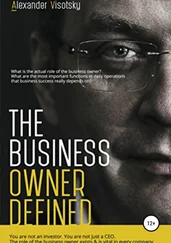Александр Высоцкий - The org board. How to develop a company structure
Здесь есть возможность читать онлайн «Александр Высоцкий - The org board. How to develop a company structure» — ознакомительный отрывок электронной книги совершенно бесплатно, а после прочтения отрывка купить полную версию. В некоторых случаях можно слушать аудио, скачать через торрент в формате fb2 и присутствует краткое содержание. Жанр: small_business, management, paper_work, на русском языке. Описание произведения, (предисловие) а так же отзывы посетителей доступны на портале библиотеки ЛибКат.
- Название:The org board. How to develop a company structure
- Автор:
- Жанр:
- Год:неизвестен
- ISBN:нет данных
- Рейтинг книги:5 / 5. Голосов: 1
-
Избранное:Добавить в избранное
- Отзывы:
-
Ваша оценка:
- 100
- 1
- 2
- 3
- 4
- 5
The org board. How to develop a company structure: краткое содержание, описание и аннотация
Предлагаем к чтению аннотацию, описание, краткое содержание или предисловие (зависит от того, что написал сам автор книги «The org board. How to develop a company structure»). Если вы не нашли необходимую информацию о книге — напишите в комментариях, мы постараемся отыскать её.
The org board. How to develop a company structure — читать онлайн ознакомительный отрывок
Ниже представлен текст книги, разбитый по страницам. Система сохранения места последней прочитанной страницы, позволяет с удобством читать онлайн бесплатно книгу «The org board. How to develop a company structure», без необходимости каждый раз заново искать на чём Вы остановились. Поставьте закладку, и сможете в любой момент перейти на страницу, на которой закончили чтение.
Интервал:
Закладка:
Александр Высоцкий
The org board. How to develop a company structure
Introduction
This book was written for the executives and owners of small to medium sized companies that are expanding, as well as anyone who makes decisions regarding the company’s structure and improvements to facilitate business growth and development. It is for those who love what they do and dream of creating a well-organized business.
When I was creating my first business, I was going through one textbook after another on the subject of management in an attempt to find the answer to this question: what is the optimum structure for my company? Without any exaggeration, I spent lots of hours researching but, in the end, was disappointed. In management textbooks I found only very general recommendations, most of which did not go beyond classifying types: the company structure can be of this type, or it can be of that type… I did not find any specific concepts regarding which structure I should choose and what criteria I should use to make that choice. Also, while reading these books, I got the impression that they are written as if one wanted to manage some global corporation from aboard a spacecraft. It was impossible to understand how to apply all these clever ideas to actual operations in a relatively small manufacturing, trading or service company.
I also knew that I would not be able to build a well-managed company if I, the founder and the CEO, didn’t have an initial "blueprint", basically – no idea of the necessary divisions and levels of employee responsibility. At that time, my manufacturing company was not very big. It had about 150 full-time employees and several independent contractors. My technical education, logic, and experience told me that without a sound organizational structure I would not be able to properly organize and expand the work, just as it would be impossible to build a beautiful building by attaching additional floors, attics, balconies, and garages to a small house. Only with a comprehensive initial plan of the entire building could it be built floor by floor.
As it turned out, this problem had a beautiful and logical solution. It is possible to develop a structure that will provide a solid foundation for organizational expansion and development, while will not changing significantly in the process of growth. As I write this, seven years of consulting and working experience with more than two hundred companies of various specializations confirm that this is not just an elegant theory. It is a real opportunity to create an optimum structure of the company, regardless of its size and stage of business development.
This book is dedicated to one of the fundamental principles of organizing work, which you will use to overcome management difficulties. Regardless the size of your company, while reading this book you will see the great potential of your business as well as the issues which limit its growth and development. You may think you already know this, but I'll take it upon myself to say that you are mistaken. If you already knew precisely the true potential of your company, and understood its weakest link – you would have already taken care of it.
I often hear from business owners that their weak spot is sales, but experience shows otherwise. Cursory research shows that sales departments function quite well, while instead management is completely oblivious to lack of advertising, or that their products are not competitive. Regardless of whether you agree or not, I promise that you will see your business in a completely new light and gain many new ideas for its expansion.
If you look around, you will find many companies in many different lines of business that have great products, but the scale of their activities has not grown for years. Why do some companies expand rapidly and within ten years go international, while others, despite their outstanding product, settle for a very small share of the market and remain at almost the same level? You will find the answer to this question in my book.
Perhaps, you will thumb through this book and see some data that seems redundant or too complex. However, if you read it consistently and carefully, you will see that these concepts are simple and useful, even for small companies. Their implementation will bring any sized business significant expansion.
After all, your personal point of view on your business fully determines its future. My recommendation is that you read this book in its entirety, and then refer to individual chapters and inserts to gain a greater understanding of specific divisions.
Management is one of the most ancient human endeavors. It can remain simple if you don’t introduce arbitrary complexities. Its basics have remained virtually unchanged since the times when the head of the tribe led his tribesmen out of the caves to hunt mammoths. Of course, modern technology (computers, the Internet, advanced means of communication, etc) gave us an opportunity to eliminate errors from daily tasks, but the basics of managing a group remain the same.
These basics will give you the knowledge to better understand how you can organize a group of people and their work. An adventure is awaiting you. After reading this book you will see your own business and any other company in a different light.
Chapter 1
Stages of development and crises of the small business
A company goes through several stages in its development; it all starts with the bright idea that answers how you can provide something of value to a certain category of customers.
We can say that this is the research and development phase of a product and its reproduction. In some business fields areas, such a technology already exists or can be acquired; while with others you have to invent or create something new.
At this stage, the company’s founder is often deeply involved with the daily activities of the company and product development. He personally organizes production or arranges delivery of goods. He thoroughly explores and implements the vision of a restaurant, or develops the services for the company. If this stage is successful, it’ll result with the first batch of satisfied customers, and your team gains the confidence that your idea translates to a business. This stage one understands the product’s actual cost, prices are developed and connections are created to get the necessary resources. The product undergoes some improvements or even a complete makeover, and you gain an insight, confirmed by experience, into your customers and distribution channels. At this stage, the company executives are not quite interested in making management as effective as it could be – all the attention is focused on product creation and bolstering a viable company.
We call this the Manual Stage, where the business founder, holding the vision and being competent, manages a small team quite well. He knows the technology for producing the product, as well as what his employees need to achieve in order to get results. As the company engages in small-scale activity, there aren’t executives and management issues do not come up. Regardless, the business is still gradually approaching the First Management Crisis. When the company hits the crisis depends on how fast the company is growing.
Once the idea proves successful and you have to turn it into a real business, then we move to the next stage. The owner begins to understand that to further expand, he needs to shift from directly managing individual employees to managing parts of the company – he needs to create a second level of managers. Whether the business owner promotes his best employees to managers or tries to hire experienced ones, the First Management Crisis deals the inevitable blow. After managers or executives are hired and established, overall efficiency usually drops.
Читать дальшеИнтервал:
Закладка:
Похожие книги на «The org board. How to develop a company structure»
Представляем Вашему вниманию похожие книги на «The org board. How to develop a company structure» списком для выбора. Мы отобрали схожую по названию и смыслу литературу в надежде предоставить читателям больше вариантов отыскать новые, интересные, ещё непрочитанные произведения.
Обсуждение, отзывы о книге «The org board. How to develop a company structure» и просто собственные мнения читателей. Оставьте ваши комментарии, напишите, что Вы думаете о произведении, его смысле или главных героях. Укажите что конкретно понравилось, а что нет, и почему Вы так считаете.












